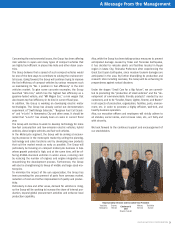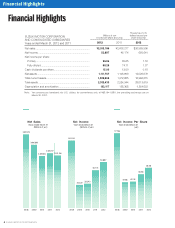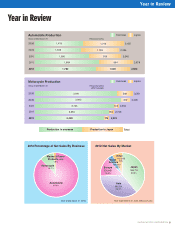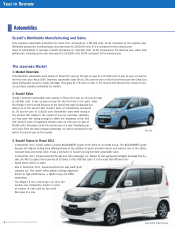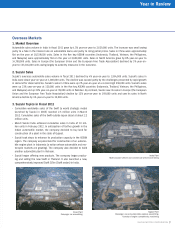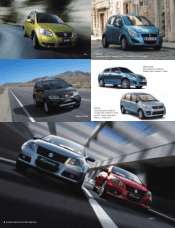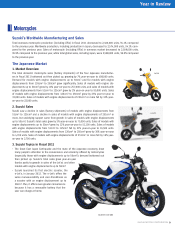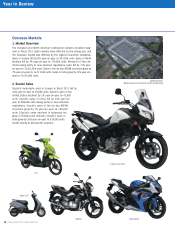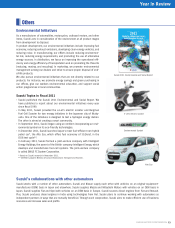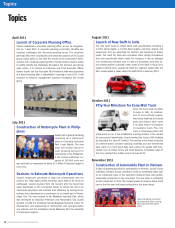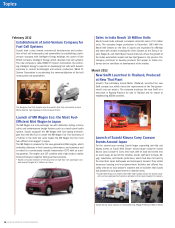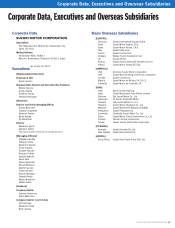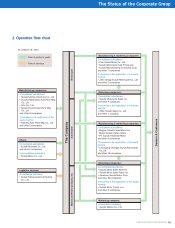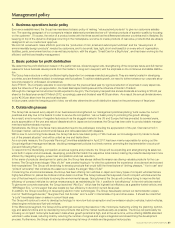Suzuki 2012 Annual Report Download - page 15
Download and view the complete annual report
Please find page 15 of the 2012 Suzuki annual report below. You can navigate through the pages in the report by either clicking on the pages listed below, or by using the keyword search tool below to find specific information within the annual report.
SUZUKI MOTOR CORPORATION 13
As a manufacturer of automobiles, motorcycles, outboard motors, and other
items, Suzuki acts in consideration of the environment at all product stages
from development to disposal.
In product development, our environmental initiatives include improving fuel
economy, reducing exhaust emissions, developing clean-energy vehicles, and
reducing noise. In manufacturing, our eorts include reducing environmen-
tal risk, reducing energy requirements, and promoting the use of alternative
energy sources. In distribution, we focus on improving the operational e-
ciency and energy eciency of transportation and on promoting the three Rs
(reducing, reusing, and recycling). In marketing, we promote environmental
management among our dealers and strive to ensure proper disposal of end-
of-life products.
We also pursue environmental initiatives that are not directly related to our
products. For instance, we promote energy savings and green purchasing in
our oces, give our workers environmental education, and support social
action programmes in local communities.
• Suzuki published the Suzuki 2011 Environmental and Social Report. We
have published a report about our environmental initiatives every year
since scal 1999.
• In May 2011, Suzuki provided the e-Let’s electric scooter and Burgman
Fuel-Cell Scooter for two energy initiatives in the Japanese city of Kitaky-
ushu. One of the initiatives is designed to test a hydrogen energy station.
The other is aimed at creating a smart community.
• In September 2011, Suzuki began using an emblem incorporating an envi-
ronmental symbol on its eco-friendly technologies.
• In December 2011, Suzuki launched Japan’s most fuel-ecient non-hybrid
petrol car*, the Alto Eco, which oers fuel economy of 30.2km/L in the
JC08 test cycle**.
• In February 2012, Suzuki formed a joint-venture company with Intelligent
Energy Holdings, the parent of the British company Intelligent Energy, which
develops and manufactures fuel-cell systems. The joint-venture company
is called SMILE FC System Corporation.
* Based on Suzuki research in November 2011.
** Veried by Japan’s Ministry of Land, Infrastructure, Transport and Tourism.
e-Let’s electric scooter
Others
Suzuki 2011 Environmental and Social Report
Alto Eco
Environmental Symbol
Suzuki works with a number of other automakers. Suzuki and Nissan supply each other with vehicles on an original-equipment-
manufacturer (OEM) basis in Japan and elsewhere. Suzuki supplies Mazda and Mitsubishi Motors with vehicles on an OEM basis in
Japan. Suzuki supplies Fiat and Opel with vehicles on an OEM basis in Europe. Suzuki sources diesel engines from Fiat and Renault.
Plus, Suzuki produces diesel engines in India using technologies from Fiat. Suzuki plans to continue working with automakers as
independent partners in ways that are mutually benecial. Through such cooperation, Suzuki aims to make ecient use of business
resources and increase sales and prots.


